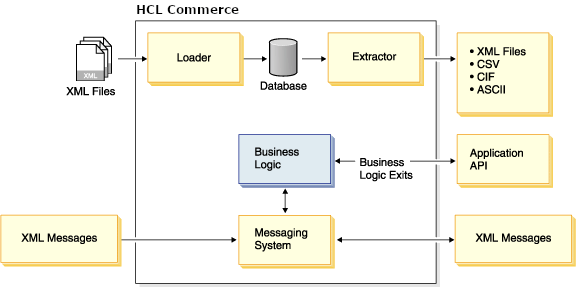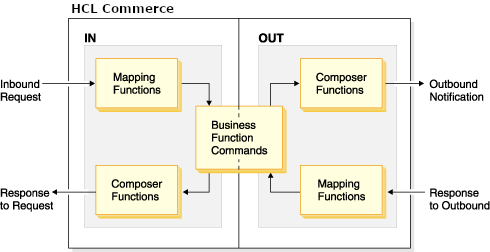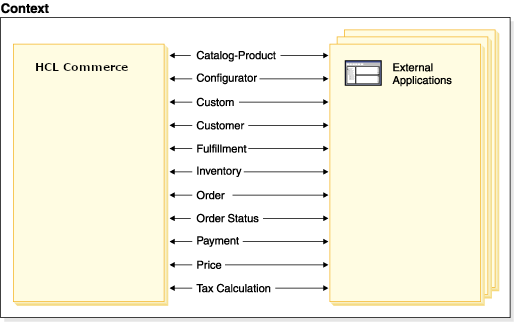Integrating with back-end systems and external applications
External systems integration is a key feature of the HCL Commerce solution. In HCL Commerce business logic is enabled for integration and built-in adapters and interfaces are provided for common integration points. Additionally, the HCL Commerce integration solution leverages integration standards by using various IBM connectivity solutions.
HCL Commerce can integrate with:
- Customers by multiple channels
- Back-end systems within the enterprise
- Partners and suppliers
The HCL Commerce messaging system gives HCL Commerce the ability to communicate with its external environment. This communication includes sending messages to and receiving messages from back-end systems or external systems, as well as sending notification to customers and administrators that events occur within HCL Commerce.
The following diagram depicts how HCL Commerce can integrate with existing applications.

For example, you can set up the messaging system to send email messages that notify your customers that their orders are shipped. You can configure HCL Commerce to send message to a back-end system whenever an order is created at your store. This order information can be used by the back-end system to do necessary order fulfillment processing. The back-end system can later send order status messages back to HCL Commerce indicating that order delivery occurred, or an order invoice is issued. An email can also be sent to update the customer.
Inbound messages are used to run commands in HCL Commerce based on messages that are coming from back-end systems. Outbound messages can be generated by the outbound messaging system in order to update back-end systems with events that occur, such as a new customer order.
HCL Commerce internal integration facilities
The following diagram shows HCL Commerce components and utilities that are used to communicate with external systems. For example, XML files can be used as input by the massload utility, which uses the files to populate the HCL Commerce database. The Extractor utility can be used to extract data from the HCL Commerce database into various file formats. XML messages are also used as input to the Messaging system, which is based on the content of the XML messages the Messaging system can perform business logic, or send messages to an external system.

Messaging architecture
The inbound messaging system can receive XML-based messages via the HTTP protocol and IBM MQ. The outbound messaging system provides a means to send email notifications to customers and administrators, send XML-based messages using the Listener for IBM MQ transport, and to write messages to a file.

Predefined messages
To speed development, HCL Commerce provides many predefined inbound and outbound messages. The predefined messages provide common messaging functionality for fulfillment and back-end messaging needs. In addition, HCL Commerce provides an architecture for adding new messages and transports.
The messaging system is prepared to send and receive a number of pre-defined messages in XML format. This format offers a high degree of readability, making the messages easy to modify and maintain. You can also use the legacy message format. However, the XML message format is recommended. You can also add new messages. For new inbound messages, you can associate them with either existing HCL Commerce commands, or commands that you create.
HCL Commerce provides several messages that the HCL Commerce system can use to communicate with an external system. In addition to the messages provided you can also create custom messages.
